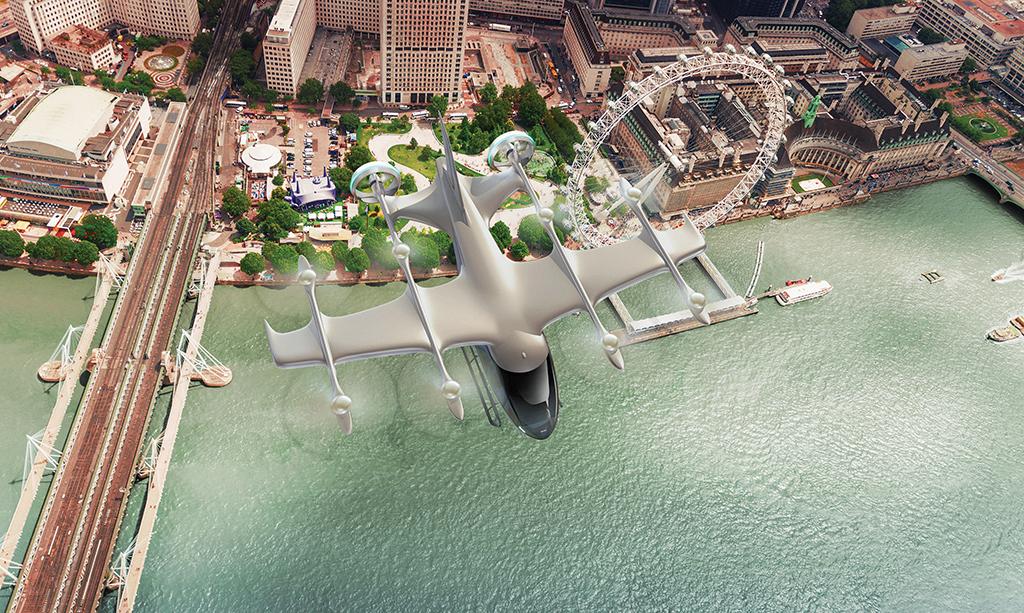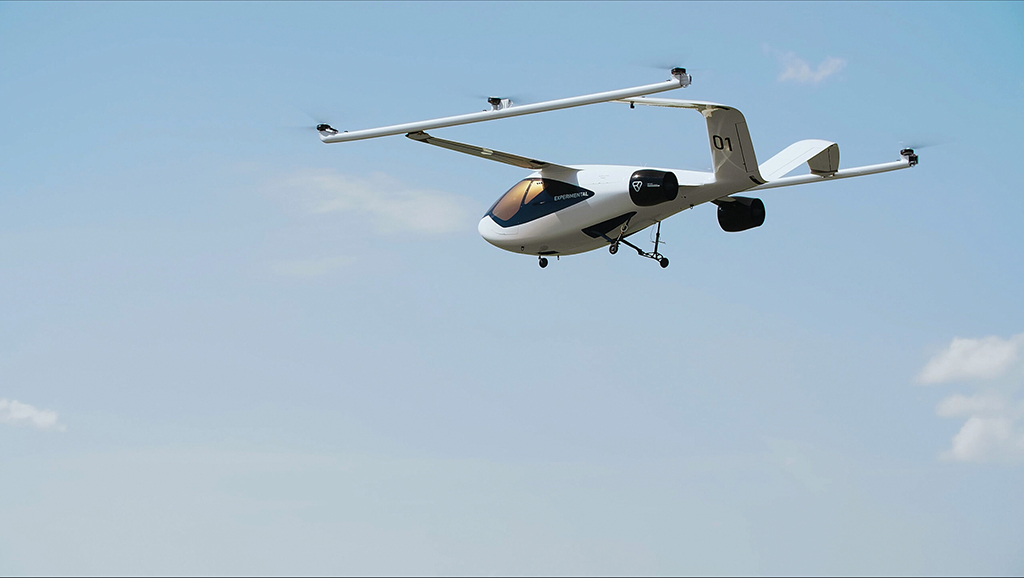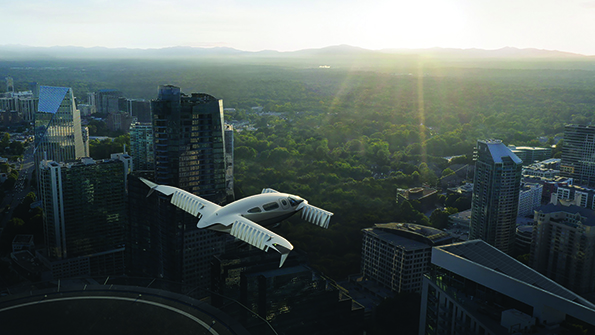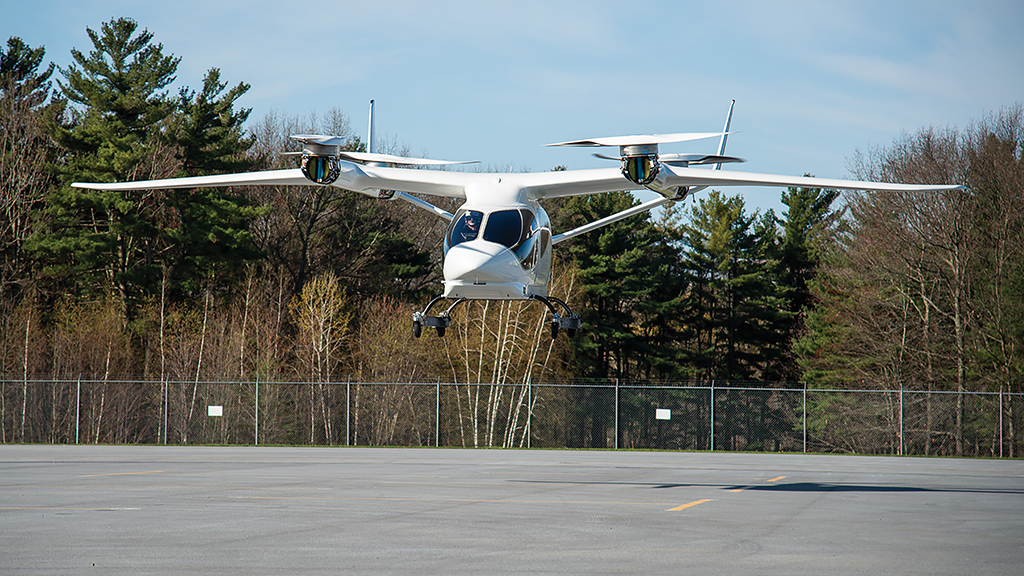
Eve’s eVTOL vehicle is focused on short-range urban air mobility.
Over the past year, the differentiation between leaders in the nascent advanced air mobility field has come into sharp focus, the consequence of differing technical choices, business approaches and operational aspirations.
The dozen or so companies vying to be the electric vertical-takeoff-and-landing (eVTOL) market survivors are on one level all in a race, but on another level they are all running on different paths. Archer Aviation and Joby Aviation, for example, may be direct competitors pursuing the same air-taxi market, but they are distinctly different companies. Those differences could prove crucial over the next two years.
- First certifications targeted for 2024
- The pressure is on to harmonize regulations
After a heady 2021 that saw billions of dollars enter advanced air mobility (AAM) companies through public listings and private placements, a layer of reality settled over the industry in 2022. Startups struggled with issues considered normal for aircraft programs but not accounted for in slick investor presentations.
Joby’s complex vehicle and vertical integration led to delays last year and pushed service entry back into 2025 from 2024. With a simpler vehicle and experienced suppliers, Archer stuck to its plan to launch service in 2025. The companies appeared to end the year neck and neck in the race to certification.
They will not be first to cross the finish line. EHang expects to gain certification of its autonomous two-seat EH216-S early this year, but the Chinese process is opaque and will not set a global standard. Approval of Volocopter’s piloted two-seat VoloCity, now expected in 2024, likely will be the milestone as the first certification under the European Union Aviation Safety Agency’s (EASA) Special Condition for VTOL (SC-VTOL).
U.S. CHANGES DIRECTION
The major event of 2022 was the FAA’s course change from type-certifying eVTOLs as Part 23 fixed-wing aircraft with VTOL capability to treating them as a special class of powered-lift aircraft under Part 21.17(b). The shift most affected those furthest along in the certification process.
Joby applied for certification of its JAS4-1 tiltprop eVTOL in November 2018, and the FAA signed the G-1 certification basis under Part 23 in May 2020. After the FAA’s U-turn, this had to be updated. The revised G-1 under Part 21.17(b) was signed in July 2022, and the FAA published the JAS4-1’s certification basis—its first for an eVTOL aircraft—in November.
While the FAA’s shift contributed to the delays that pushed Joby’s service launch into 2025, Archer was less affected. The G-1 for the startup’s M001 Midnight eVTOL was approved in September 2021, the revised G-1 was signed in November and the certification basis published for comment in December—a faster pace that kept Archer on track for service launch in 2025.
Both Joby and Archer expected the majority of their means of compliance under Part 21.17(b) to be accepted by the FAA by the end of 2022, making it a closely run race—on paper. But Joby has been flying full-scale pre-production prototypes of the JAS4 since 2019. Archer’s 80%-scale Maker demonstrator achieved transition in December, but the full-size pre-production Midnight-0 will not fly until this year.
Joby in May 2022 received the Part 135 air carrier certificate for its planned aerial ride-sharing service and began gaining experience operating an internal shuttle with the Cirrus SR22. In October, the startup partnered with Delta Air Lines to launch a city-to-airport service in 2025 for premium passengers in Los Angeles and New York. Delta invested an initial $60 million of a potential $200 million in Joby.
Archer does not expect to receive its Part 135 certificate before 2024, but in November it announced plans with investor United Airlines to launch its first route in 2025 between the Downtown Manhattan Heliport in New York and Newark Liberty International Airport in New Jersey, with other cities to follow. United has made a $10 million down payment on 100 of the 200 Midnight eVTOLs it has on preorder.
Joby has begun low-volume production at its pilot plant in Marina, California, with investor Toyota providing manufacturing expertise, but it has yet to choose a location for higher-rate Phase 1 production. Archer in November selected Covington, Georgia, as the site for its manufacturing plant, and initial production aircraft are planned to roll off the line by the end of 2024.
Archer has ambitious plans to produce 250 eVTOLs in 2025 and ramp up to the Covington plant’s initial capacity to produce 650 aircraft per year by the third year, after which the site has the capability to be expanded up to 2,300 vehicles a year. The plan is built on automaker Stellantis being Archer’s contract manufacturer, providing production technology, personnel and up to $150 million in capital for the Covington plant.
Joby and Archer remain the best-funded of the eVTOL startups but are spending significant amounts of cash as they progress into certification and production—an expected $320-340 million in 2022 for Joby and $220-230 million for Archer. Joby has filed to raise up to another $1 billion over the next three years, while Archer has stepped up its outreach to investors. Both must fund not only the ramp-up of production but also the establishment of air-taxi operations.
Joby’s vertical integration—airframe, propulsion system, flight controls and other components are all produced in-house—contributed to both expenses and delays in 2022. But the company continues to maintain that the approach produces a higher-performing vehicle and will pay off in the long term. “This is a heavy lift . . . but it is going to pay massive dividends,” founder and CEO JoeBen Bevirt said in November.
Because of internal delays, Joby appears to have missed its target to fly the first “production-intent” prototype by the end of 2022. While not fully conforming, this aircraft is close to the final certification configuration. Some systems, including the electric propulsion units, are at an earlier “design-intent” stage and have not yet been through enough development testing to be declared production-intent.
The year ahead will determine whether Archer wrests the lead from Joby. “We have questions around the complexity of Joby’s design and whether it might need more time to certify than Archer’s,” says Sergio Cecutta, partner at SMG Consulting. “Archer is developing a product with commercialization in mind, and that might lead to a simpler certification path than Joby’s.”
SMG also questions when Joby will select the site for its scaled assembly line and what Toyota’s involvement will be. “Archer’s production plans are aggressive, but they are introducing an innovative manufacturing model to aerospace—contract manufacturing—that could give them a leg up,” he says.
The third runner in the U.S. eVTOL race, Beta Technologies, could not be more different than Joby and Archer. The startup, backed entirely by private investment, is targeting cargo as the first application and has conducted all flight testing of its full-scale Alia-250 eVTOL piloted rather than uncrewed.
But Beta has yet to demonstrate transition between thrustborne vertical and wingborne horizontal flight and has not agreed on a G-1 certification basis with the FAA. The startup is building a manufacturing facility in Burlington, Vermont, but has yet to unveil its production aircraft or its supplier partners.
Since the aircraft will spend more than 90% of its time in wingborne flight, Beta’s approach has been to expand the Alia’s fixed-wing flight envelope through testing of a conventional-takeoff-and-landing prototype lacking lift rotors. This includes flying 336 nm on a single charge in December. VTOL flight testing has been underway since May with a second prototype.
Beta saw significant progress through 2022, completing a $375 million Series B funding round with additional funding from Amazon’s Climate Pledge Fund, booking firm orders from the Bristow Group and lessor LCI Aviation and conducting demo flights at UPS’ package hubs. The year ended with a successful 50-ft. drop test of Beta’s battery pack with the FAA and National Institute for Aviation Research.
But the startup is taking time agreeing on its G-1 with the FAA, hoping to address some of the issues it sees with the proposed certification bases for the Joby JAS4-1 and Archer M001. Even though the lift-plus-cruise Alia is a simpler vehicle than either of its rivals, the delay makes meeting Beta’s stated goal of certifying by the end of 2024 look increasingly unachievable.
“Beta seems to be going slow, as they have an entirely manned flight campaign, but they are quietly performing to their plans,” Cecutta says. “We are confident in them but see a slip to a 2025 entry in service as likely.”
Like Joby, Beta has a second route to market in the shape of the U.S. Defense Department. Both are working with the U.S. Air Force’s Agility Prime program to enable early operations with the military as a path to commercialization of eVTOLs. Beta’s agreement has expanded to include the U.S. Army and Joby’s to encompass the U.S. Marine Corps. Both companies expect to begin operations on logistics missions on military bases in 2024, but the path forward should become clearer in 2023.
Looking ahead, the key concern for the U.S. eVTOL leaders, and for overseas startups seeking FAA validation of their certifications so they can begin operations in the U.S., is the FAA meeting its promise to finalize rules for the operation of powered-lift aircraft by the end of 2024. This is a prerequisite for starting commercial operations in 2025.
The notice of proposed rulemaking for the powered-lift special federal aviation regulation is expected to be released for public comment in the spring, timing that will put pressure on the FAA rulemaking process if the deadline is to be met. “There is a lot of political will surrounding AAM and pushing the FAA to make it a priority,” Cecutta notes.
EUROPE HOLDS COURSE
In comparison, European regulators have made faster and straighter progress. EASA published its SC-VTOL in July 2019, establishing the requirement that eVTOLs carrying passengers on commercial operations over congested areas achieve the same safety level as commercial airliners.
Since then, the regulator has completed two tranches of means of compliance with the SC-VTOL and issued a third for public comment, published draft operating and licensing rules for consultation and released prototype vertiport design specifications, largely keeping pace with what industry needs to launch commercial operations.
Volocopter is the first to put the SC-VTOL to the test. Despite being first to fly a piloted multicopter in 2011, the German startup has experienced the inevitable drag of certification. But the company was first to fly a conforming prototype, in December 2021, and is now on a path to launch commercial air-taxi service with the VoloCity in 2024 at the Paris Olympics, as well as in Rome and Singapore.
Volocopter raised another €252 million ($275 million) in Series E private investment in 2022, after abandoning plans to list publicly in 2021 through a merger with a special-purpose acquisition company (SPAC). The startup also flew its longer-range, four-seat VoloRegion (formerly VoloConnect) in May 2022 and now has three eVTOLs in development including the VoloDrone uncrewed cargo aircraft.
Volocopter was involved in the commissioning of the first two test vertiports in Europe: in October 2022 at Rome’s Fiumicino Airport and in November at the Pontoise Aerodrome on the outskirts of Paris. Test flights with the VoloCity are slated to begin at both locations this year. Volocopter also has unveiled its first planned route in Singapore, a tourist flight over Marina Bay.
With one of the simplest vehicles in the eVTOL race, Volocopter is holding to its strategy of entering the market with short-range airport shuttle and aerial tourism flights, then expanding into logistics and suburban routes. Even then, the company is not underestimating the challenges.
“It will be very intense in order to be able to get the type certificate and then to prepare for all necessary approvals to be able to fly in Summer 2024 in Paris,” Dirk Hoke, Volocopter CEO and former Airbus Defense and Space CEO, said at the opening of the Pontoise vertiport.
“A simpler vehicle design has paved the road for a less risky certification path,” Cecutta says. “However, their design still raises some questions on operations and profitability with only one passenger. We do not think money is an issue, and we see the change of chief technology officer [in January] as a sign that the program is out of development and proceeding toward commercialization.”
In contrast to Volocopter’s steadfastness, rival German startup Lilium announced a shift in its go-to-market strategy in 2022, delaying plans to launch a regional air mobility service to instead focus on initial sales of its Lilium Jet eVTOL to the premium market and private buyers.
Lilium cites significant interest from premium customers as the reason for the change, but the move also allows the company to secure predelivery payments of at least 50% from private buyers to shore up its finances. The company plans to build 50 Lilium Pioneer Edition aircraft for this market, priced at €10 million versus €7 million for the regional shuttle version.
Lilium already has booked a firm commitment for 10 Pioneer Edition Jets, including predelivery payments and an option for another 10, from UK private aviation operator Volare and expects to sell all 50 by the end of 2023, netting at least €250 million in down payments.

The company expected to end 2022 with around $273 million in cash after raising an additional $119 million from investors in November but estimates it needs to find an additional $540 million to fund operations through to type certification, according to a filing with the U.S. Securities and Exchange Commission. The predelivery payments will help, but more is needed.
“The fact that Lilium needs an additional half a billion dollars to certify is a cause of great concern, especially in a financial climate deemed by Wall Street experts as a ‘horrific environment to raise capital,’” Cecutta says. Citing the appointment of a new chief financial officer in January, he says: “The recent changes in leadership seem to point to a renewed emphasis on capital raising and orders.”
Lilium did make technical progress last year, accomplishing full transition with its uncrewed subscale demonstrator in September. A second demonstrator will join the test program soon, and assembly of the first type-conforming Lilium Jet is planned to begin this year.
A similar funding situation exists at UK startup Vertical Aerospace, which must raise more money if it is to reach certification and is looking to customers holding 1,450 conditional preorders and options for predelivery payments to bolster its finances.
Vertical announced a predelivery payment commitment from American Airlines in July 2022 for 50 of the 250 VX4 eVTOLs is has on preorder, but the deal was delayed. In January, Japanese conglomerate Marubeni made a payment to reserve delivery slots for 25 of the 200 VX4s it has on preorder.

The UK startup began hover-testing of its full-scale VX4 demonstrator in September. The aircraft was piloted but tethered to the ground and connected to external electrical power. The aircraft’s battery system now is being commissioned and its flight controls upgraded to allow untethered testing to begin, aiming initially to achieve semiwingborne flight at up to 40 kt.
Vertical is to certify the VX4 with the UK Civil Aviation Authority using SC-VTOL regulations and says the aircraft is planned to enter service “mid-decade.” The company has less funding in hand than its rival eVTOL developers, but a traditional aerospace industry approach of relying on suppliers to fund development of their systems means its cash-burn rate is lower than for the others, at $100-120 million a year.
“The cash on hand is a concern, but their quarterly cash burn is running around a third that of the other top OEMs, and Vertical has access to $90 million-plus in their equity subscription line,” Cecutta says. “They should be in acceptable financial condition for 2023.”
For Vertical and other European startups a key issue going into 2023 is the lack of harmonization between EASA and the FAA on eVTOL certification. Concern that this could affect FAA validation of SC-VTOL certification has emerged in comments on the proposed certification bases for the Joby JAS4-1 and Archer M001. The FAA’s acceptance of a lower safety level than the SC-VTOL is the major issue.
CHINA ADDS RUNNERS
China’s EHang was an early mover in the eVTOL industry but, like Volocopter, has experienced certification headwinds. Despite having produced a substantial number of aircraft and flown more than 30,000 trial flights, many carrying passengers, EHang told analysts in December that it expects certification of the two-seat EH216-S from the Civil Aviation Administration of China (CAAC) in January. This would be the first eVTOL, and the first autonomous air taxi, to achieve type certification.
While certification was delayed by China’s COVID-19 pandemic lockdowns and other issues, the startup says it has completed more than 6,800 operational trial flights under its CAAC-sanctioned 100 Air Mobility Routes Initiative. These were mainly short sightseeing flights over tourist attractions, the planned launch market for EHang’s air-taxi services.
Although designed to be autonomous, the multicopter EH216 was captured in video released in December being flown manually by EHang founder and CEO Huazhi Hu. Early investor and customer United Therapeutics insisted on a manual piloting mode being available as an option, which may provide a way for the vehicle to be certified outside of China.

“We do not think the EH216 is a viable aircraft for markets driven by FAA and EASA regulations, as they do not foresee certifying an autonomous passenger carrying aircraft till the next decade,” Cecutta says, “However, China should be a big enough market to make their first passenger aircraft successful.”
While EHang has faced delays, a slew of other Chinese eVTOL developers have entered the market. These include AutoFlight, Pantuo Aviation, TCab Tech, Vertax, Volant Aerotech and even automakers Geely, Volkswagen Group China and XPeng.
XPeng AeroHT unveiled the X3 drive/fly multicopter eVTOL in October and released video of the hover flight of a full-scale test vehicle. Volkswagen China revealed the first full-scale prototype of the V.MO autonomous four-seat eVTOL in July, and video of its first flight was released on Jan. 23. Geely’s Aerofugia subsidiary rolled out a full-scale VTOL demonstrator in August.
Amid this burst of activity, Shanghai-based AutoFlight took the unusual step of establishing a German subsidiary in January 2022 with the intent of designing and certifying its Prosperity 1 eVTOL in Europe under the SC-VTOL but engineering and manufacturing the vehicle in China, where costs are lower. In October, Omer Bar-Yohay, co-founder of electric-aircraft developer Eviation, was named CEO of AutoFlight, and the company opened an office in California with plans to flight-test in the U.S.
“They could be a best of both worlds, Western certification standards and Chinese supply chain costs,” Cecutta says. “We are expecting to see their production design, the timing of which could have been impacted by the arrival of the new leadership.”
As for the other Chinese eVTOL hopefuls, “we think the issue right now is capital in China,” he says. “The economic slowdown has impacted startups the most, and the ramp-up in COVID cases is significantly impacting their schedules.”
PLAYING A LONGER GAME
A significant number of the eVTOL leaders are looking to certification beyond 2025, giving more time for certification concerns to be resolved. These include Embraer startup Eve as well as other established aircraft manufacturers such as Airbus and Textron.
Eve completed a going-public merger with a SPAC in May 2022. The deal underperformed, raising only $377 million, but the startup secured a $15 million investment from United Airlines in September along with a preorder for 200 aircraft. And in December Brazil’s national development bank BNDES approved two credit lines totaling $92.5 million.
The startup has yet to fly a full-scale vehicle but says it is in on track for Brazilian certification and deliveries beginning in 2026 against a backlog of more than 2,100 preorders. “Our focus is really on delivering the aircraft to market, not so much flying demonstrators for the sake of it,” Eve co-CEO Andre Stein says.
“We are not ready to call 2026 infeasible, and the question is: With Embraer possibly shelving their 90-seat turboprop and being the majority shareholder, will their strategic focus for the next five years be Eve’s certification and commercialization?” Cecutta says.
Airbus plans to fly its CityAirbus NextGen in 2024 and now expects the winged multicopter eVTOL to enter service in 2026. The European airframer has pivoted to emergency medical services, augmenting air ambulance helicopters, as the expected first-use case for the vehicle.
Karem Aircraft spinoff Overair received a boost in last June with an additional $145 million in funding from main shareholder Hanwha, taking the South Korean group’s total investment so far to $175 million. California-based Overair plans to fly a full-scale uncrewed demonstrator for its Butterfly tiltrotor eVTOL by year-end or early in 2024, with the production aircraft to follow later in the decade.
“The announcement that their majority partner Hanwha is going to produce batteries [with South Korea’s LG Energy Solution] means Overair will have privileged access to the most supply-chain-critical component,” Cecutta says. “We believe they are making quiet progress.”
Wisk received a $450 million investment from joint-venture shareholder Boeing in January 2022 and unveiled its “Generation 6” production eVTOL design, an autonomous four-seater, in October. The startup has yet to reveal when it expects to certificate the aircraft with the FAA, but it anticipates beginning operations by the end of the decade.
Wisk is unlikely to certify its vehicle before 2028, which is also the date set by Hyundai company Supernal for market entry of its eVTOL urban air mobility (UAM) vehicle. Supernal has been established in the U.S. to pursue FAA certification, and while details of the production vehicle remain sparse, the company has been working to develop an ecosystem to support the eventual deployment of UAM.
Textron’s new eAviation electric aircraft business, meanwhile, has taken over Bell’s Nexus eVTOL program and is building a demonstrator. Now using a combination of tilting propellers and lift rotors, rather than ducted fans, the aircraft is being developed with Bell, Textron Aviation, McCauley, Pipistrel other Textron businesses and is aimed at a “potential” market entry by the end of the decade.

Comments